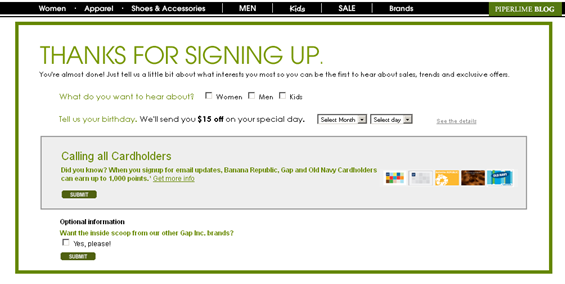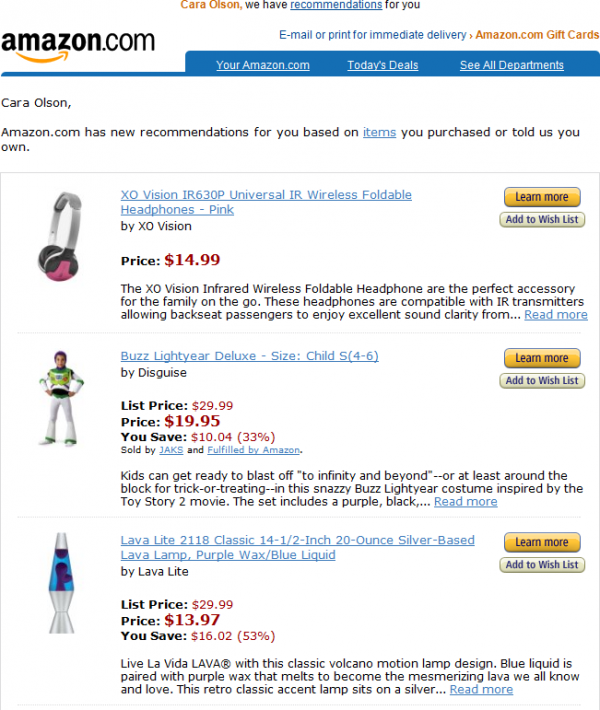Explicit And Implicit Email Preferences
Email is seemingly tailor-made for collecting customer information. In a perfect program, collection begins at the point of sign up. Yet marketers know the fewer the questions asked, the more likely the customer is to opt-in. It’s a balancing act, though, because marketers also know that the more demographic data they can collect at that […]
Email is seemingly tailor-made for collecting customer information. In a perfect program, collection begins at the point of sign up. Yet marketers know the fewer the questions asked, the more likely the customer is to opt-in.
It’s a balancing act, though, because marketers also know that the more demographic data they can collect at that point, the easier it will be to deliver relevant, timely emails throughout the span of the relationship. Lack of relevancy will result in unengaged subscribers, poor engagement metrics, junk-mail placement and, ultimately, unsubscribes.
Building a smarter sign-up form goes a long way toward providing you with the information you need to honor your commitment to relevancy. Even incremental improvements to your existing intake forms are valuable steps forward.
By intelligently incorporating both explicit preferences and implied preferences in your build, you can better engage and retain your subscriber base.
In The Beginning
Keeping in mind that you want to keep information requests to a minimum at sign-up, limiting the number of questions to three or less, one of which is email address.
From there, ZIP code, gender and birthday are likely the next most important pieces of data to collect, depending on what is most relevant to your objectives and strategy. With each additional question over three, you’ll begin to introduce an additional percentage of breakage into the process, so there is a definite incentive to keep your request as narrow as possible.
Obviously, if you channel customers through a checkout process, you are also collecting far more valuable information such as physical address (through the user’s shipping information) and product purchase history, in addition to email address.
Checkout is your best opportunity to collect a significant amount of information. If the subscriber did not sign up as part of checkout, then your confirmation/thank-you page is the next best opportunity to ask for additional information. Still, it is important that you keep your request to a minimum to give yourself the best shot at a response.
Perhaps your initial signup simply asks for email address and ZIP code. On the confirmation screen, thank the user for signing up and ask for one or two additional pieces of information — such as gender and birthday — and offer to send a reward for that information.
Following is an example of this best practice from Piperlime:
Immediately after collecting the initial sign-up information, send the first welcome email of a series to the subscriber.
Here, deliver the offer promised upon sign-up and ask the user to update their preferences to ensure he/she receives the most from their email relationship with your brand. This directs the user to your preference center.
As discussed in a previous post about triggered emails, the welcome email has one of the highest open rates of any email — this is one of your best chances to ask the subscriber for preference information.
Depending on your brand, these questions can range from favorite color, to children’s names and birthday, to a preferred style or product line.
While your preference center can be more thorough in the number of questions, it still needs to be aesthetically pleasing and should leverage your brand’s voice to increase the success rate of completion.
Take a look at this example from Ikea, which only prompts for additional information after the user clicks Yes, No, etc.
Behavioral
As soon as you are sending emails to your subscriber, you are collecting data on their email behavior, including, of course, opens and click-throughs.
These behaviors create implied preferences which are established through a subscriber’s interactions with the emails they receive. Open and click-through data can be incorporated into RFM/eRF scoring, which can identify segments and opportunities for targeted messaging.
Acting on these implied preferences can also be as simple as highlighting a section of navigation which appears to be more relevant to a subscriber, based on previous click-through behavior.
In this example from Old Navy, Baby Boys is targeted for one subscriber (in the navigation highlighting and call out by the logo), and Girls is targeted for another subscriber.
Conversions are the most valuable behavioral data. Purchases allow you to match an email address with a physical address.
Furthermore, tracking products purchased establishes additional preferential data and allows you to customize future email content. Purchase tracking also generates a series of additional triggered emails destined for higher engagement rates — and another golden opportunity to collect additional data from the customer.
However, relying on purchase data can backfire if not correctly done. Take Amazon for example. I am still receiving recommendations for products that I already purchased.
Not only are they annoying me with duplicate suggestions, but they’re missing the opportunity to show me something that I might be genuinely interested in spending money on. Amazon needs to update their recommendation logic to exclude products previously purchased, as I do not need two of any of these items.
Appended Data
Whether your subscribers willingly provide additional preferences or not, you can seek out additional preferences via third-party data.
This can range from demographic data like birthday and gender, to psychographic insights like hobbies and interests. You can also append phone number to email address records, in addition to physical address.
Keep in mind that data sourced from third parties will never be as accurate as preferences directly updated by the subscriber. However, it can be a step in the right direction by increasing email engagement.
Creating data models of your best subscribers that help you gain insight as to their behaviors can then allow you to identify which unengaged subscribers are worth targeting for re-engagement, and which subscribers you can comfortably part ways with.
eCRM
When a user provides their email address to sign up, he or she may not be new to your brand. The person might already be a customer. If so, the email address they’ve been convinced to provide could be appended to their existing customer record.
Data cannot be effective in silos and must be integrated across channels and sources. Enter the concept of eCRM — the need to establish a single view of a customer record. Your data warehouse will need to be able to “hold” single records which may only contain an email address and then potentially merge it with an existing record once you recognize it belongs to the same individual.
Finally, while customers who provide their email addresses have been shown to have a higher value to the brand, remember that the individual can be disengaged with a single channel, like email, and still be considered engaged.
Look at an individual’s overall engagement with your brand, i.e. their in-store purchase history, in addition to which marketing channels are most effective with them, i.e. their response to direct mail marketing, to create the optimal 1-1 communication strategy.
The Chicken And The Egg
As stated above, email is seemingly tailor-made for data collection. Used intelligently, it can not only drive revenue, but can also be something of a self-perpetuating process.
You use the data you collect to drive better engagement, leading to more sales. Those sales lead to better opportunities for data collection — data that you’ll use, in turn, to make your emails more relevant, again driving sales.
Getting the ball rolling from the outset makes it all the more valuable for you.
Contributing authors are invited to create content for MarTech and are chosen for their expertise and contribution to the martech community. Our contributors work under the oversight of the editorial staff and contributions are checked for quality and relevance to our readers. MarTech is owned by Semrush. Contributor was not asked to make any direct or indirect mentions of Semrush. The opinions they express are their own.
Related stories
New on MarTech




